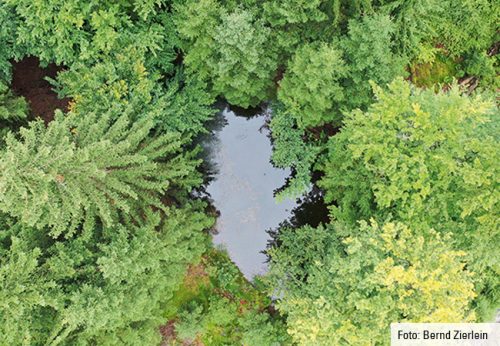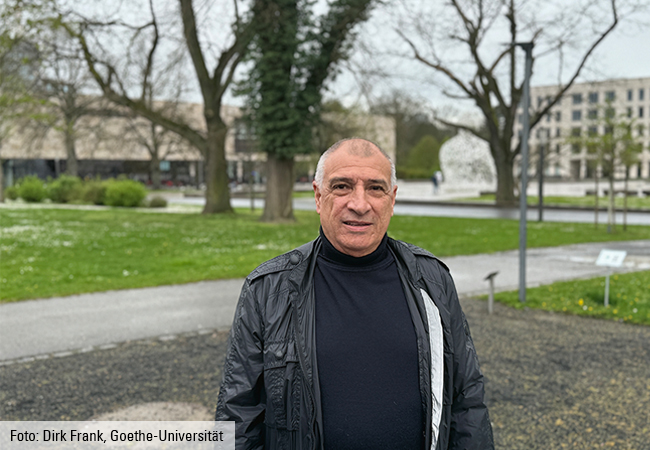Jasmin Thal’s Master’s thesis makes an important contribution to aquatic ecology. The environmental scientist produced a guide on how to retain water in forests, which is being prepared for practical application in cooperation with the Königstein forestry office (HessenForst).
Jasmin Thal is a passionate nature photographer who likes “focusing” on shy birds and is particularly appreciative of places where a special peace and quiet prevails that is not interrupted by the ringing of cell phones. “When the weather permits, you can always find me outside,” says the environmental scientist, who, in a sense, has turned her hobby into her profession.

In what later turned out to be the foundation for her future specialty, Thal wrote her Bachelor’s thesis in aquatic ecology under the supervision of Dr. Heike Zimmermann-Timm, who teaches at Goethe University Frankfurt’s Institute of Ecology, Diversity and Evolution. “I wanted to write my Master’s thesis on a related topic. Together, Ms. Zimmermann-Timm and I came up with the question of how forests could be made more climate-resilient and the role played by bodies of water in them. While larger forest lakes were the subject of investigation in the 1990s, there’s very little research literature on smaller bodies of water.” Heike Zimmermann-Timm, who set up the connection with the forestry office in Königstein, confirms this research gap. Given that the topic of forests and water recently was incorporated into the Hessian state forests’ nature conservancy guidelines for the first time, the staff in the forestry office were very pleased to know that smaller water bodies – from ponds and pools all the way to water-filled tire tracks and ditches – will also become the subject of investigation. The guidelines also explicitly mention the role of small water bodies, including artificially created ponds and pools, even though to date nothing is known about their importance in the forest.
Together with the forestry office, Thal identified an area measuring about one square kilometer on the Feldberg in the Taunus hills near Frankfurt, which already contains ponds, making it a suitable research location. Given its geological subsoil and very steep slopes, it is difficult for precipitation to seep through the ground. As a result, the surface water generally runs down the hills and in cases of extreme precipitation can make the streams burst their banks and cause flooding.
Jasmin Thal started by dividing the area into smaller transects to map out all water-containing structures. “We even discovered two ponds that the forestry office didn’t know about,” she recounts. The six existing ponds were examined for their hydromorphology, i.e. water depth, water residence time and chemistry (oxygen and nutrient content). An additional focus was on recording the animals inhabiting the water, particularly the amphibians.

Artificially created ponds are also important for water retention and biodiversity in forests, but stressors such as climate change and falling leaves can cause major problems for the small water bodies. Fallen leaves in the water accelerate silt formation, especially if the water depth is less than 20 centimeters. To combat the disappearance of the small bodies of water it is therefore important to remove bushes from the banks where possible. When it comes to restoring a dried up pond, excavation is a last option, not least because this would entail an enormous disruption to the biotope.
That is why it is so essential to always consider measures that are compatible with wildlife protection, Thal explains. “A certain amount of silting up is necessary, also to maintain the habitat for amphibians and other species of animals. Our experience shows that every pool and every pond must be individually assessed. For example, if we find that a pond has already developed into a bog, we cease all intervention since a bog can retain and store even more water than a pond.” Recommendations have been drafted for the Königstein forestry office on retaining the water in the forest for a longer period, including measures for looking after ponds, locations for creating new ones, and possible connections between existing ponds.
“It’s important to me that my students get a certain feel for practice,” explains Heike Zimmermann-Timm, herself an aqueous ecologist, adding that her observations from the past few years have led her to conclude that many upcoming environmental scientists are not sufficiently familiar with nature, partly due to structural changes in their degree programs. “If you’re handling water samples in the lab without knowing how and where they were taken and where the pollution comes from, that’s a real deficit.” There is also room for improvement when it comes to communication and knowledge transfer, she adds, explaining that environmental scientists today have to work together with a wide range of target groups and know what’s important to each. “It was a great advantage for Jasmin Thal that she was in contact with the forestry office while working on her Master’s thesis. It definitely takes a certain sensitivity coupled with an assertiveness, especially when you find yourself in discussions with your coworkers about why it would be better not to undertake particular excavations which might damage a biotope or the habitat of amphibians. At the same time, it is important to acknowledge the need to ensure that machines and staff are deployed in a way that conserves their resources, too.” Knowledge about publicity work is also essential, Zimmermann-Timm says, so as to inform people about necessary ecological measures in good time and on a sound scientific basis.
For Jasmin Thal her practical final project has already paid off, because she now has a job in the nature conservancy administration in Southern Baden. “It’s important to me to support nature conservation through my work as well,” she emphasizes, pointing to how pleased she is that in addition to the recommendations for action, her Master’s thesis is going to be published now, too.













